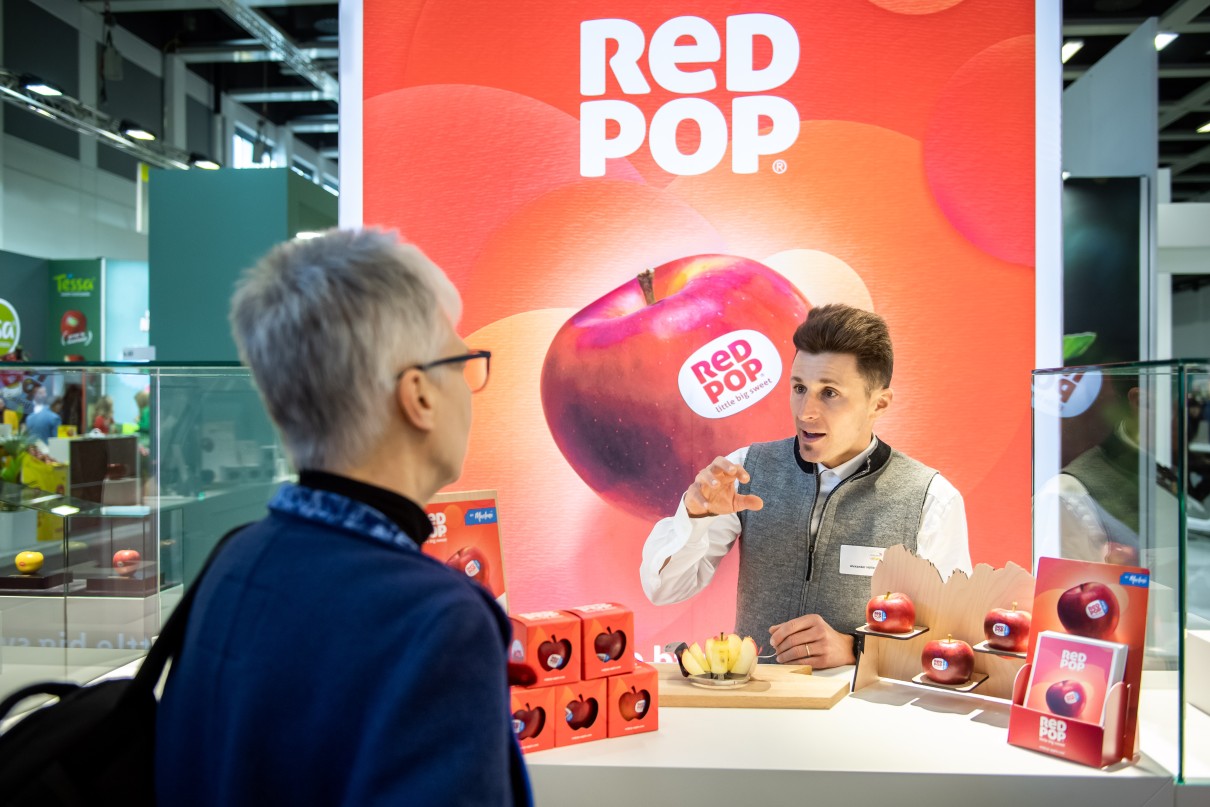Page content
“An apple should be crunchy and juicy“

Mr. Höller, how did you become an apple sommelier?
The training course is the result of a collaboration between several organisations: the South Tyrolean apple industry, the South Tyrolean Apple Consortium and the South Tyrolean Farmers Association. The focus is on tasting and learning to distinguish an apple’s flavour, aroma and texture. I grew up with apple trees and today represent the third generation managing our farm. We have some ten apple varieties, so I am really very familiar with the apple industry. Nevertheless, I’m always looking towards new horizons and want to learn something new. As an ambassador for the apple trade I already provide an insight into the world of apples and agriculture. My qualification as an apple sommelier is an extra bonus.

Andreas Höller fascinates trade visitors at FRUIT LOGISTICA with one of his apple varieties.
How do I approach tasting an apple?
To begin with I should mention that apples have around 300 different aromas. I didn’t know that either. What one tastes is of course very subjective and depends on the variety of food one consumes. People who rarely eat a kiwi won’t notice the smell or taste of one in a Cosmic Crisp. When tasting an apple we activate our five senses. First of all we look at an apple and its colour and shape. Then we hold it to our nose, sniffing and already smelling some aromas. Then we take a bite. How hard it is to take that bite and what happens in our ears tells us whether an apple is crisp. The first bite is decisive. Chewing the apple tells us if it is crunchy and retains that crispy note. At the same time I can tell how juicy it is. And then I can slice it and feel the texture of the flesh with my tongue. That tells me whether the apple has a grainy or smooth texture, and I can also smell more aromas. During tasting, that balance between sweet and sour is usually dominant. When chewing one takes one’s time to try and associate the experience with familiar aromas of fruit, flowers or spices
Which apple varieties are especially popular?
I personally find texture very important, meaning an apple should be crunchy and juicy. In my opinion it is not always the taste or the aromas that are the main thing, but the experience as well. At FRUIT LOGISTICA we tasted several apple varieties for example. What characterised the most popular ones was not so much aromas but their juiciness.
Why do people generally like apples?
Apples are easy to carry around. They even fit in a bike jersey and in summer they quench your thirst. After all, they are 85 per cent water. There are so many different varieties and flavours, so there is something there for everyone. Apples are also readily available. They are probably one of the most widely cultivated types of fruit.
In South Tyrol especially. Why is this region so good for growing apples?
With an area of 18,000 hectares, we are Europe’s largest single apple-growing region. But it actually represents only 2.5 per cent of the surface area of South Tyrol. Apple-growing takes place mainly in the valleys and on their edges, from 200 to 1100 metres above sea level. We have both humus-rich soil and sufficient water, which we manage very carefully. In our region we also have four distinct seasons. In the winter the apples are dormant, after which spring must arrive quickly for a long vegetation period. In our meadows the Pink Lady for example flowers in April, but in some cases is still harvested on 15 November. It simply needs a lot of sun and time to ripen.
To which countries does the apple harvest go?
We sell around half of our production in Italy. Germany is the second-largest market. Other European countries including Austria and Spain also make up a share. Very little goes to overseas markets because we do not target them. For us, shipping over short distances is important to ensure apples remain a more or less regional product. The refrigeration systems of our collectives are a special feature. The apples hibernate so-to-speak in a controlled atmosphere of one degree Celsius. The ripening process stops and they retain all of around 30 nutrients.
How do you select the varieties you grow on your farm?
The testing centre in Laimburg carries out studies on more than 300 new varieties every year. It can take up to 20 years before we launch a new variety in South Tyrol. In the end, it is up to each individual farmer if they want to take the risk of a new variety. For me personally it has to taste good as well.
What was your impression of FRUIT LOGISTICA 2024?
It was my second time at the fair and I had fascinating conversations, not just about apples. I am also interested in other types of fruit from different parts of the world. After the event I actually had a visitor from Brazil here in South Tyrol who took the time to tour apple production on our farm. That really was something quite special.

